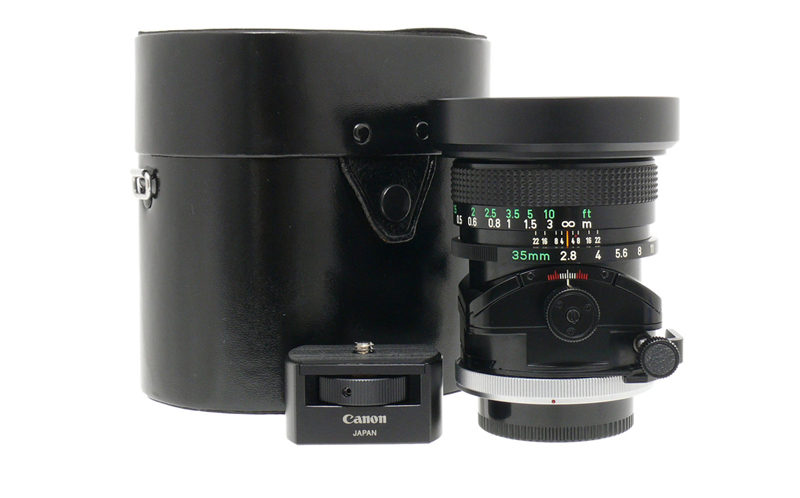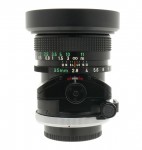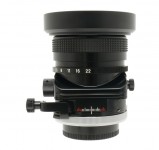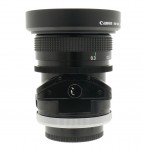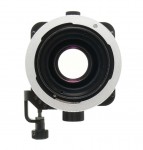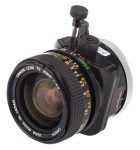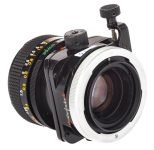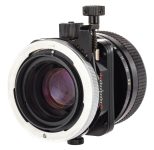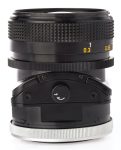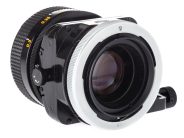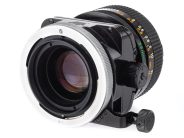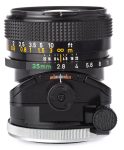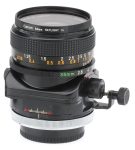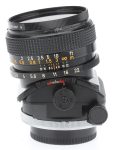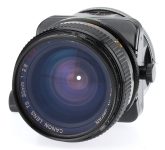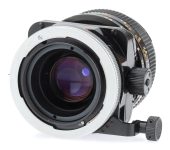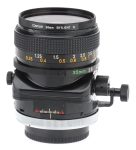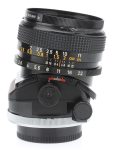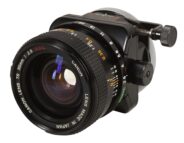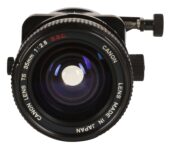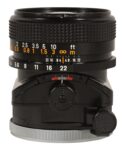Canon FD TS 35mm F/2.8 S.S.C.
Shift lens • Film era • Discontinued
- Announced:
- · March 1973
- Production status:
- ● Discontinued
- Country of design:
- · Japan
- Original name:
- · CANON LENS TS 35mm 1:2.8 S.S.C.
- Class:
- · Fast full-frame shift lens
- · Professional model (Top class)
- System:
- · Canon FD (1971)
Abbreviations
| FD | The lens is designed for Canon 35mm film SLR cameras with the Canon FD mount. |
| TS | Perspective Control. |
| S.S.C. | Multi-layer Super Spectra coating is applied to the surfaces of lens elements. This anti-reflection coating increases light transmission, eliminates flare and ghosting, and maintains color consistence among all lens models. |
Model history (2)
| ■Canon FD TS 35mm F/2.8 S.S.C. | M | 9 - 8 | 0.30m | ⌀58 | 1973 ● | |
| ■Canon FDn TS 35mm F/2.8 | M | 9 - 8 | 0.30m | ⌀58 | ● | |
Specification
| Optical design: | |
| 35mm full frame | |
| 35mm | |
| F/2.8 | |
| 9 elements in 8 groups | |
| Floating element system | |
| Canon FD [42mm] | |
| 63.4° (35mm full frame) | |
| Diaphragm mechanism: | |
Diaphragm type: | Manual |
Aperture control: | Aperture ring |
| 8 (eight) | |
| Focusing: | |
| 0.30m | |
| 1:5.2 | |
Focusing modes: | Manual focus only |
Manual focus control: | Focusing ring |
| Perspective control mechanism: | |
Shift range: | -11..0..+11mm |
Tilt range: | -10..0..+10° |
| Yes | |
| - | |
| Physical characteristics: | |
| 550g | |
| ⌀67×74.5mm | |
| Accessories: | |
| Screw-type 58mm | |
| BW-58B - Bayonet-type round | |
| <No data> |
Sources of data
- Manufacturer's technical data.
- Canon FD instructions (PUB. II01-012A) (October 1978).
- Canon FD interchangeable lenses booklet (PUB. IE01-075) (May 1979).
- Specifications of Canon New FD lenses (PUB. C-II-099B) (July 1981).
- Canon FD lenses booklet (PUB. CE1001J) (December 1974).
- Canon FD interchangeable lenses booklet (PUB. C-IE-075AF) (May 1981).
- Canon FD interchangeable lenses instructions (PUB. A5368) (February 1974).
- Canon interchangeable lenses sales guide.
- Quick reference guide.
- Canon AE-1 booklet (PUB. CE1057) (June 1976).
- Canon AE-1 Program booklet (PUB. C-CE-124) (December 1980).
- Canon AL-1 Quick focus booklet (PUB. C-CE-135A) (January 1982).
- Canon EF instructions (PUB. IE 1008P) (May 1976).
- Canon F-1 booklet (PUB. CE1017F) (December 1975).
- The New F-1 World booklet.
- Canon A-1 booklet (PUB. C-CE-0990) (September 1980).
- Canon AE-1 booklet (PUB. C-CE-1056AB) (September 1980).
- Canon AT-1 booklet (PUB. CE1065) (November 1976).
- Canon F-1 booklet (PUB. NO5367Q) (September 1974).
- The pinnacle of optical perfection. Canon FD lenses booklet (PUB. CE1006F) (March 1973).
- Canon FD lenses sales guide.
- Canon FD lenses inctructions (PUB. A5368z) (January 1978).
- Canon interchangeable lenses FD booklet (PUB. C-IE-075AQ) (March 1982).
- Canon FD lenses instructions (PUB. II01-061I) (July 1979).
- Canon FD lenses booklet (PUB. CE-1006J) (September 1974).
- Canon FD interchangeable lenses booklet (PUB. C-IE-075AL) (December 1981).
- Canon FD Lenses in a Nutshell booklet (PUB. IE-1033Q) (April 1979).
- Canon AE-1 - A new generation booklet (PUB. CE1056A) (July 1976).
- Canon Products Guide (PUB. C5077d) (January 1973).
- Canon AE-1 booklet (PUB. C-CE-1056Y) (February 1980).
- Canon Products Guide (PUB. E5077t) (April 1978).
- Canon Products Guide (PUB. D5077k) (November 1975).
- Canon Products Guide (PUB. CE01-114B) (July 1979).
- Canon AT-1 booklet (PUB. CE1074H) (December 1977).
- Canon EF instructions (PUB. IE 1008L) (September 1975).
- Canon Products Guide (PUB. D5077n) (February 1976).
- Canon Products Guide (PUB. D5077s) (August 1976).
Manufacturer description #1
This unusual lens has a vertical tilt for altering perspective and a horizontal shift for altering depth of field independent of aperture. It can be rotated on its mount for tilting/shifting in any direction, and it has a floating system for uniform sharpness over the entire image even at its 30cm (1 ft.) minimum focusing distance. It is especially suited to architectural photography where it can be used, for instance, to correct the "backward-leaning effect" of tall buildings, or for oblique shots of walls, shop fronts, trains. It is most appreciated for its ability to stretch depth of field without having to stop down. Since it also has great potential in exaggerating perspective or understating depth of field, it is also a handy tool for exercising individual expression.
Manufacturer description #2
The world first "tilt and shift" wide angle lens for 35mm SLR cameras. The "tilt and shift" mechanism changes relation between the lens optical axis and the film plane to obtain special effects. "Tilting" is used to swing the plane of focus so that it is not parallel with the film plane. You can adjust focus using the tilt mechanism to a very shallow or a very deep zone without change of aperture. "Shifting" is used to correct or enhance perspective distortion, shifting the optical axis from the center of the film plane. The tapering off of the building in the picture can corrected by "shifting" the TS lens easily. The "TS" stands for "tilt and shift". The image circle has been increased from 43mm to 58mm to cover the entire negative at maximum tilt and shift.
Manufacturer description #3
The TS 35mm f2.8 is a lens of remarkable capabilities. It shifts off the optical axis for correction of perspective distortion, special effects and shooting around stationary obstacles. In addition, it tilts on or off axis to increase depth-of-field at any aperture, utilizing the Scheimpflug principle a technique previously available only to view camera users. This feature will be appreciated by product or architectural photographers who must maintain absolute image sharpness under difficult conditions. To insure a high degree of image sharpness and even illumination, the image circle has been increased.
Manufacturer description #4
It is indispensable for shooting distortion-free architectural photographs. Tilting and shifting can be performed individually or in combination. Shooting range and the depth of the field can be controlled. Diffused reflection has been eliminated with Canon's multi-layer coating treatment technique. At the same time, Canon's Floating System was adopted to prevent image degradation in close-up photography.
Manufacturer description #5
This is a special type of lens that can provide both tilting and shifting simultaneously and its high performance comes to enhance the F-1 System's versatility. It compensates perspective by shifting and, at the same time, it extends the depth of field by tilting the lens. It covers an image circle of 58mm and it eliminates flare completely.
From the Modern Photography magazine (March 1974)
Most 35mm photographers don't think of their SLR's as miniature view cameras capable of tilting and shifting the lens for perspective corrections. But there are more than a few architectural, industrial and scientific photographers who wish they could borrow these movements from their large, slow, but supremely flexible view cameras and graft them onto their nimble, compact 35's. It's hardly a new idea. A few camera and lens manufacturers, such as Schneider and Nikon, presently offer perspective correction lenses in the 35mm format. But because of the complex mechanical and optical requirements, nobody had heretofore succeeded in incoporating both shifting and tilting movements in one 35mm lens body.
To build in both capabilities, you must start with a well-corrected lens having a very large covering power, and then mount it in a very complex. mechanically precise barrel. Canon finally took up the challenge.
Though hardly diminutive for a 35mm f/2.8, Canon's TS (for tilt and shift) lens looks rather small for such an involved mechanism because of its fine black finish. It is actually 3 1/16 in. long, 3 1/3 in. wide (at the widest part where the shift control knob extends 1 1/4 in. from the barrel) and weighs a hefty 1 lb. 3 oz. Of course, you can hand hold the TS for field shooting, but it's primarily designed to do its job on a tripod-mounted camera where you can check the finder image with maximum precision. And while the Canon FTb's or F-1's viewing standard screen may also be used (minus the microprism with the lens in tilted position), Canon recommends that F-1 owners use a "D" screen with the TS lens. This is a completely matte screen which has graph paper style lines crossing its entire surface. The matte surface helps you focus to the corners of the field, while the cross lines show the degree of perspective correction.
This lens does not have an automatic diaphragm because the tilt-and-shift mechanism is so complex they couldn't fit it in. Fortunately, it really doesn't need one for the slow, deliberate type of shooting that is this lens' forte. A manual diaphragm is actually advantageous with a lens that must be stopped down frequently to check which planes of the subject are in focus at shooting aperture. So, when you meter with this lens, you also do so at the working aperture.
Now let's see how those tilting and shifting mechanisms work. Just behind the front-mount focusing and aperture rings is a curved arc-shaped metal flange which slides smoothly towards either side on a similarly shaped base as you turn a lightly-knurled, 5/8-in. wide knob atop the lens. Right in front of this knob is a red-and-white degree scale, the central portion of which is white to indicate that shifting the lens (while tilting) is possible within this marked 6° (3° either side of center) range without going beyond the lens' image circle. Beyond the white scale area, there are red marks up to 8° on either side of the center line - the maximum tilt angle. On the bottom of the lens, exactly 180° from the tilt-control knob, is another knob which locks the lens in any tilted position. If you tilt the lens toward the subject the proper amount, you can considerably increase the useful depth of field without stopping the lens down - just like a view camera. But here the view camera analogy breaks down. Most view camera lenses are of normal construction - that is, they have fixed nodal points. If you tilt such a lens at the central part of its barrel. the resulting image shift is very small and you usually don't need to refocus. But since the TS Canon is an inverted-telephoto-type lens, it sticks out rather far from the nodal point to begin with and even further when you tilt the lens toward the edge of its image circle. As a result, the nodal point is just not in the same place it was before. Put simply, quite a bit of image shift occurs when you tilt an inverted-telephoto lens and, consequently, you must recompose the framing of the picture and check corner-to-corner sharpness.
So far, we've been talking about this lens with its tilt mechanism oriented horizontally (the vantage point that allows you to view all clearly engraved white-on-black numerals on the 3/16-in. wide, click-wholestopped aperture ring from directly above). But what if you want to tilt the lens vertically? No problem. Just grab it by the squared-off rear part of the barrel and turn it up to 90° clockwise or counter-clockwise for a total on-axis turning capability of 180°. For convenience, there are detents every 30° and yet another detent for the non-tilted position.
Now, on to the shifts. Obviously, the lens' turnability enables any shift movements to be used for rising and falling as well as sliding (or shifting) horizontally, depending on where you turn the lens mount In any case, as you turn the knob nearest the camera body, the whole body of the lens (including the tilting mechanism) moves in a plane parallel to the film plane. The central 7mm shift on either side of the center position is indicated by white scales. Beyond 7mm, the shift is indicated by a red scale to warn you that you cannot shift that much while tilting. Otherwise, your pictures may suffer from image cutoff.
Normally, this lens comes with its tilting movement set at right angles to the shift. In extreme applications, you might prefer that both movements be controlled in parallel. Canon made the base flange of the lens (just in front of the shift mechanism) perfect for just such requirements. Just bring your TS Canon lens to any authorized Canon service station and they'll shift your tilts and shifts to suit you in about a minute. It's so simple we're tempted to tell you to do it yourself, but there's a snag. The screws on all late-model Canon lenses are locked in place by a special bonding substance that resists vibration and, unless you're experienced and have precisely the right tools, you'll probably scratch the beautifully finished lens barrel. By the way, if your TS Canon doesn't quite clear the tripod platform in tilted position, that's no problem - the lens comes with a Canon Tripod Adapter which raises the camera body clear of the mechanism.
Other shift lenses in the Canon FD system
| ■Canon FD mount (1) | |||||||||
| Canon FDn TS 35mm F/2.8 | M | 9 - 8 | 0.30m | ⌀58 | ● | ||||
Lenses with similar focal length
| ■Canon FD mount (2) | |||||||||
| Arax 35mm F/2.8 S&T | P | 11 - 8 | 0.30m | ⌀62 | ● | ||||
| Hartblei Super-Rotator 35mm F/2.8 TS-PC MC | M | 11 - 8 | 0.20m | ⌀82 | ● | ||||
| ■Interchangeable mount (2) | |||||||||
| Schneider-Kreuznach PC-Curtagon 35mm F/4 MC | M | 7 - 6 | 0.30m | ⌀49 | ● | ||||
| Schneider-Kreuznach PA-Curtagon 35mm F/4 | M | 7 - 6 | 0.30m | ⌀49 | 1967 ● | ||||
